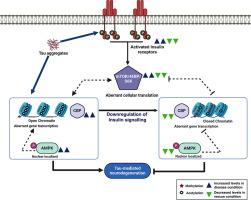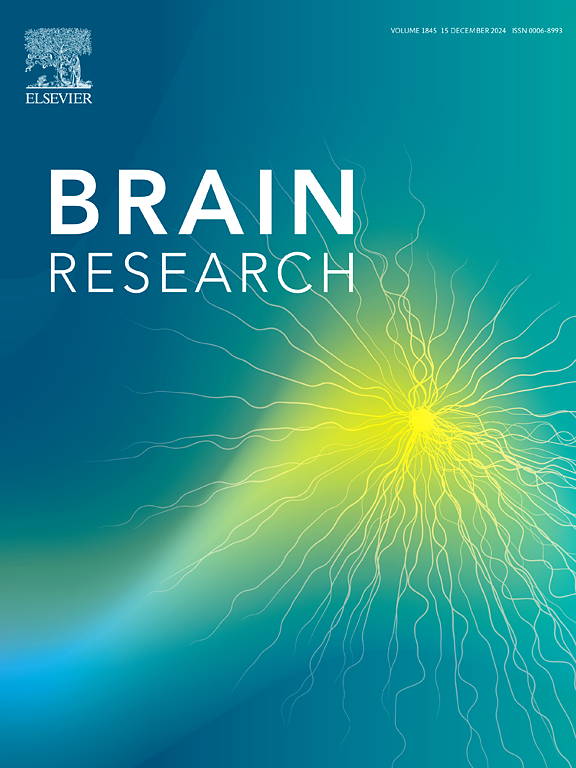胰岛素信号传导的靶向下调通过恢复果蝇的异常异染色质丢失和mTOR/4EBP/S6K通路限制了人类tau发病机制。
IF 2.7
4区 医学
Q3 NEUROSCIENCES
引用次数: 0
摘要
Tau病是一组神经退行性疾病,其特征是成对螺旋丝(PHFs)/或神经纤维缠结(NFTs)在神经元/神经胶质细胞中堆积。除了 tau 蛋白的过度磷酸化外,异染色质的异常丢失和翻译功能障碍也是导致该疾病发病机制的重要因素。最近,我们报道了组织特异性下调胰岛素信号或其促进生长的下游分支可有效恢复tau介导的过度激活的胰岛素通路,并限制致病性tau高磷酸化和聚集体的形成。我们接下来研究了下调胰岛素通路或其促进生长的下游分支是否会对tau介导的异常异染色质丢失和翻译功能障碍产生影响。我们首次证明,组织特异性下调胰岛素信号或其促进生长分支可有效限制致病性 tau 诱导的异染色质丢失。我们进一步报告说,果蝇表达人类 tau 会诱导 mTOR/4EBP/S6K 通路和能量失衡,而当胰岛素信号下调时,能量失衡会得到有效平衡。我们的研究结果表明,胰岛素信号在果蝇中有效缓解tau病因的各个方面(包括过度磷酸化、染色质松弛和翻译激增)起着至关重要的作用。我们的发现将有助于建立针对tau病症的新型治疗方案。本文章由计算机程序翻译,如有差异,请以英文原文为准。

Targeted downregulation of insulin signaling restricts human tau pathogenesis by reinstating the aberrant heterochromatin loss and mTOR/4EBP/S6K pathway in Drosophila
Tauopathies are a group of neurodegenerative diseases characterized by the accumulation of paired helical filaments (PHFs)/or neurofibrillary tangles (NFTs) in neuronal/glial cells. Besides hyperphosphorylation of tau protein, aberrant heterochromatin loss and translation dysfunction have emerged as other important aspects contributing to the disease pathogenesis. We have recently reported that tissue-specific downregulation of insulin signaling or its growth-promoting downstream sub-branch effectively reinstates the tau-mediated overactivated insulin pathway, and restricts pathogenic tau hyperphosphorylation and aggregate formation. We next investigated if the downregulation of the insulin pathway or its growth-promoting downstream sub-branch makes any impact on tau-mediated aberrant heterochromatin loss and translation dysfunction. For the first time, we demonstrate that tissue-specific downregulation of insulin signaling or its growth-promoting branch effectively restricts the pathogenic tau-induced heterochromatin loss. We further report that expression of human tau in Drosophila causes induction of the mTOR/4EBP/S6K pathway and energy disbalance which gets effectively balanced upon downregulation of insulin signaling. Our findings establish an imperative role of insulin signaling in effectively mitigating various aspects of tau etiology in Drosophila ranging from hyperphosphorylation, chromatin relaxation, and translational upsurge. Our findings could be beneficial in establishing novel therapeutic options against tauopathies.
求助全文
通过发布文献求助,成功后即可免费获取论文全文。
去求助
来源期刊

Brain Research
医学-神经科学
CiteScore
5.90
自引率
3.40%
发文量
268
审稿时长
47 days
期刊介绍:
An international multidisciplinary journal devoted to fundamental research in the brain sciences.
Brain Research publishes papers reporting interdisciplinary investigations of nervous system structure and function that are of general interest to the international community of neuroscientists. As is evident from the journals name, its scope is broad, ranging from cellular and molecular studies through systems neuroscience, cognition and disease. Invited reviews are also published; suggestions for and inquiries about potential reviews are welcomed.
With the appearance of the final issue of the 2011 subscription, Vol. 67/1-2 (24 June 2011), Brain Research Reviews has ceased publication as a distinct journal separate from Brain Research. Review articles accepted for Brain Research are now published in that journal.
 求助内容:
求助内容: 应助结果提醒方式:
应助结果提醒方式:


